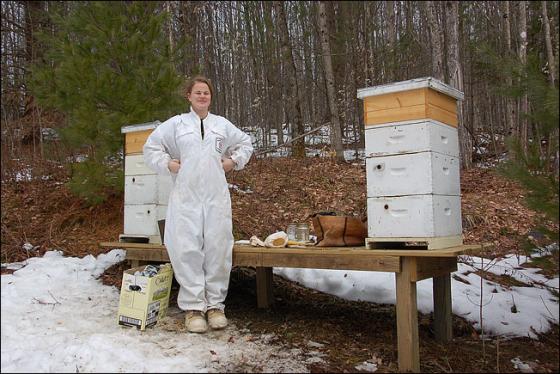Posted March 17, 2022 at 10:36am by Anonymous (not verified)
Planet Pollinators

Written by Dan Childs and Marda Donner
Read more in Vermont's Local Banquet Spring 2014 issue.
As I look out my window in early January at my beehives, I’m in awe of how bees do what they do. The temperature is well below zero, the wind is blowing, and snow is falling. Yet if I bundle up to brave the elements, go outside, and put my ear against the side of one of the hives, I can hear the low rumble of my bees.
They survive Vermont’s brutal winter by clustering into a ball with the queen in the middle. As the temperature drops, the ball gets tighter. Bees on the outside eat a dollop of stored honey and slowly migrate to the inside, where they detach their wings from their wing muscles, exercise those muscles, and in the process, generate enough heat to keep the center, where the queen is, a toasty 70 degrees.
Honeybees are incredible creatures. They are the most efficient pollinators on the planet and help us produce a lot of the food we eat, including fruits, berries, melons, vegetables, nuts, coffee, and chocolate. They pollinate the clover and alfalfa on which our dairy cows graze. And, of course, they produce real honey. If there were no honeybees, our diets would be pretty bland.
Unfortunately, bee populations throughout the United States are declining. Loss of habitat, widespread pesticide use, diseases, and mites are all taking a toll. When I started beekeeping, yearly losses were pretty manageable. Now they average roughly 33% every year. My wife, Marda Donner, and I make up losses by buying new bees or splitting the colonies that survived the winter. Sometimes we catch bees that have swarmed—in other words, have split off from their original hive.
We have somewhere between 15 and 25 hives spread out on 7 farms in Brookfield and Randolph Center, including our own. Usually, we can count on 600 to 700 pounds of honey from our bees over the course of a summer. However, the weather can play havoc with that number, and 2013 was particularly difficult for us. The wet May and June meant that the bees stayed holed up in their hives. Pollen and nectar sources were routinely washed off flowers by the rain, and the overcrowded hives had a tendency to swarm. As a result, in 2013 we harvested only a bit more than 100 pounds of honey. Although it was a low honey production year, the bees did a fantastic job on the apples, and we made more than 200 gallons of cider in October.
Looking outside today it is hard to imagine that within 90 days the bees will start venturing out to find sources of pollen and nectar. Maples provide one of the earliest sources of food and allow colonies to build up populations for the big feast—dandelion. After that, there is the apple bloom, clover, squash, and other fruits and vegetables, followed by goldenrod and asters in the fall. Then once again, the bees cluster up, and the cycle starts over.
